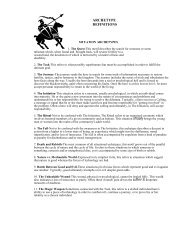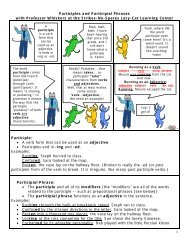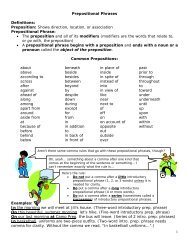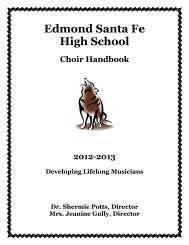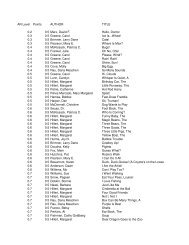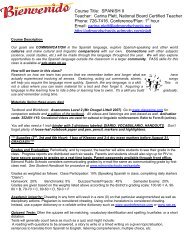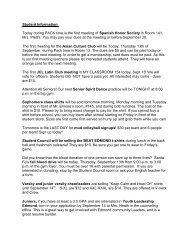SG-Ch 7 Learning.pdf - Edmond Public Schools
SG-Ch 7 Learning.pdf - Edmond Public Schools
SG-Ch 7 Learning.pdf - Edmond Public Schools
Create successful ePaper yourself
Turn your PDF publications into a flip-book with our unique Google optimized e-Paper software.
2<br />
<strong>Learning</strong><br />
at<br />
its<br />
_<br />
rs<br />
APPLICATIONS:<br />
Classical conditioning is all around us. It is especially common<br />
in the realm of emotional behavior. Test your understanding of<br />
the basic elements of classical conditioning in the following<br />
example. Then, consider whether there are emotions of your<br />
own that might have developed as the product of classical<br />
conditioning.<br />
As a child, you were playing in the yard one day when a<br />
neighbor's cat wandered over. Your mother (who has a<br />
terrible fear of animals) screamed and snatched you into her<br />
arms. Her behavior caused you to cry. You now have a fear of<br />
As a child, you were playing in the yard one day<br />
when cats. a neighbor's cat wandered over. Your mother<br />
(who 10. The has NS, a then terrible CS is fear ______________________________<br />
of animals) screamed and<br />
snatched you into her arms. Her behavior caused you<br />
to11. cry. The You US is now ______________________________________<br />
have a fear of cats.<br />
10.<br />
12.<br />
The<br />
The CR<br />
NS,<br />
is<br />
then<br />
______________________________________<br />
CS is<br />
13. The UR is ______________________________________<br />
-----------<br />
11. The US is<br />
---------------<br />
14. You always rattle the box of dog biscuits before giving<br />
12. The CR is<br />
---------------<br />
your dog a treat. As you do so, your dog salivates. At first,<br />
13. The UR is<br />
rattling the ---------------<br />
box is a _ which eventually becomes a __ .<br />
14. Your always dog's salivation rattle the is a box . _ of dog biscuits before<br />
givinga. your NS; CS; dogCR<br />
a treat. As you do so, your dog<br />
salivates. At first, rattling the box is a _<br />
b. CS; NS; UR<br />
which eventually becomes a __<br />
. Your<br />
dog'sc. salivation NS; US; CR is a .<br />
_<br />
a. NS; d. US; CS; NS; CRUR<br />
b. CS; NS; UR<br />
c. NS; US; CR<br />
d. US; NS; UR<br />
Objective 7-3: Summarize the processes of acquisition,<br />
Objective 7-3:Summarize the processes of acquisition,<br />
extinction, extinction, spontaneous spontaneous recovery, recovery, generalization, generalization,<br />
and<br />
and discrimination. discrimination.<br />
Use the following graph as a reference for the<br />
Use answers the following to 15(a), 19(b),and graph as 20(c). a reference for the<br />
answers to 15(a), 19(b),and 20(c).<br />
Strong TI a. CS+ us b. CSalone c.<br />
Strength<br />
ofCR<br />
Weak I , ~ n_ .. __<br />
::::::000..""<br />
Time<br />
15. The initial learning of a conditioned response is called<br />
15. The initial learning of a conditioned response is<br />
(a) _______________________ . For many conditioning<br />
called (a)<br />
. For many conditioning<br />
situations, the optimal interval between a<br />
situations, the optimal interval between a neutral stimulus<br />
and the US is _______________________<br />
neutral stimulus and the US is<br />
_______________________ .<br />
16. When the US is presented prior to a neutral stimulus,<br />
conditioning (does/does not) occur.<br />
17. Sexual conditioning studies with quail demonstrate that<br />
classical conditioning is highly adaptive because it helps<br />
animals _______________________ and<br />
_______________________ .<br />
18. The procedure in which an established conditioned<br />
stimulus is paired with a different<br />
_______________________ stimulus, thereby establishing<br />
the latter as a _______________________ stimulus, is called<br />
_______________________-_______________________<br />
_______________________ ,<br />
19. If a CS is repeatedly presented without the US,<br />
(b) _______________________ soon occurs; that is, the<br />
CR diminishes.<br />
20. Following a pause, however, the CR reappears in<br />
response to the CS; this phenomenon is called<br />
(c) _______________________<br />
_______________________ .<br />
21. Subjects often respond to a similar stimulus as they<br />
would to the original CS. This phenomenon is called<br />
_______________________ .<br />
22. Humans and other animals can also be trained not to<br />
respond to _______________________ stimuli. This<br />
learned ability is called _______________________<br />
23. Being able to recognize differences among stimuli has<br />
_______________________ value because it lets us limit<br />
our learned responses to appropriate stimuli.<br />
STUDY TIP: Some students find the terms discrimination and<br />
generalization confusing because of their negative social<br />
connotations. In the context of classical conditioning,<br />
discrimination is a healthy sign that the subject of conditioning<br />
has learned the difference between two stimuli, much as a<br />
"discriminating coffee lover" can taste subtle variations<br />
between two coffee blends. Generalization is apparent when<br />
discrimination does not occur.<br />
16. When the US is presented prior to a neutral stim-




